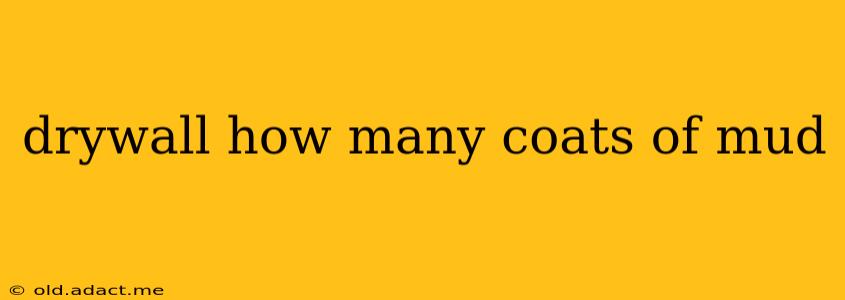Finishing drywall involves applying multiple coats of joint compound, often called "mud," to achieve a smooth, seamless surface ready for paint. The number of coats needed isn't fixed; it depends on several factors. This guide will delve into the specifics, answering common questions and providing expert advice to ensure a professional-looking finish.
How Many Coats of Mud are Typically Needed for Drywall?
Generally, you'll need two to three coats of mud for most drywall finishing projects. However, this is a guideline, not a hard and fast rule. A single coat might suffice for minor repairs, while more demanding situations might require four or even more. The key is to build up the mud gradually, allowing each coat to dry completely before applying the next. Rushing the process will almost certainly lead to cracks and imperfections.
What Factors Determine the Number of Coats?
Several factors influence the number of coats required:
- Type of Joint: Tape joints require more coats than butt joints. The wider the joint, the more mud you'll need to fill it. Inside corners often require additional attention and multiple coats to achieve a perfectly smooth finish.
- Drywall Type: Different types of drywall may require varying numbers of coats. For example, thicker drywall may need slightly more coats for a seamless blend.
- Skill Level: Experienced drywall finishers often achieve excellent results with fewer coats than beginners. Practice and skill lead to efficiency and fewer imperfections.
- Desired Finish: A flawless, perfectly smooth finish will require more care and more coats than a finish that tolerates slightly more texture.
- Joint Compound Type: All-purpose compounds, lightweight compounds, and setting-type compounds dry at different rates and may require adjustments to the number of coats.
What Happens if You Don't Apply Enough Coats?
Insufficient coats can lead to several problems:
- Visible Tape: The tape may show through the finished surface.
- Uneven Surface: The wall may appear bumpy or uneven to the touch.
- Cracks: The drywall may crack in areas where the mud hasn't adequately filled the joint.
- Poor Paint Adhesion: Paint may not adhere well to a poorly finished surface, leading to peeling or other issues.
What Happens if You Apply Too Many Coats?
While too few coats is problematic, too many coats can also create issues:
- Excessive Drying Time: Each additional coat adds significant drying time to the project.
- Increased Material Costs: More mud translates to higher material costs.
- Uneven Finish: Too much mud can lead to an uneven, textured surface that is difficult to sand. It can also increase the chances of cracking as the heavy layers shrink and dry.
How to Apply Drywall Mud Properly for Optimal Results?
Proper application is key. Here's a summary:
- Prepare the Surface: Clean the area thoroughly.
- Apply the First Coat: Use a thin, even coat of mud over the taped joints. Embed the tape fully.
- Allow to Dry: Let the first coat dry completely before sanding.
- Apply Subsequent Coats: Apply subsequent coats, feathering the edges to blend seamlessly into the surrounding drywall.
- Sand Between Coats: Sand each coat thoroughly before applying the next to remove imperfections.
- Final Sanding: Perform a final sanding to achieve the desired smoothness.
- Prime and Paint: Prime the finished drywall before painting for optimal paint adhesion.
What Type of Mud Should I Use?
The choice of joint compound depends on the job. All-purpose compounds are suitable for most applications. Lightweight compounds are ideal for larger areas, reducing weight and drying time. Setting-type compounds dry faster but require more experience.
How Long Does Drywall Mud Take to Dry?
Drying time depends on factors like humidity, temperature, and the thickness of the applied coat. Allow ample drying time between coats to prevent cracking and ensure proper adhesion. Check the manufacturer's instructions for recommended drying times.
By following these guidelines, you can achieve a professional-looking drywall finish with the appropriate number of mud coats, ensuring a durable and aesthetically pleasing wall surface. Remember, patience and careful application are key to success.
